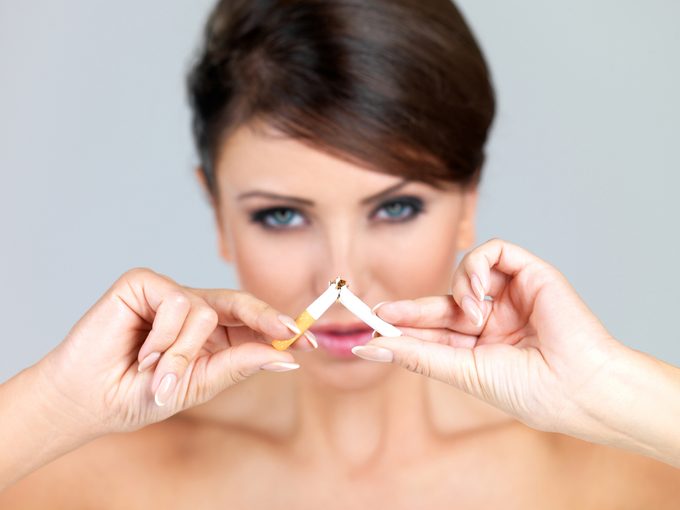How Quitting Smoking Can Give You Gorgeous Skin
There’s one more reason to quit smoking: it wrecks your looks. Find out how quitting can reverse the damage and improve your skin.

In the battle against evil tobacco, there’s good news: Smoking rates across Canada continue to fall to their lowest in more than four decades, even among teens, many of whom now view it as uncool. (The percentage of Canadians aged 15 to 19 who smoke dropped from 44 percent in 1981 to 18 percent in 2005.) For the rest of us, thanks to smoking bans in public places across Canada, a night out no longer entails coming home reeking of smoke. In fact, quitting is contagious: A recent study published in The New England Journal of Medicine found that when one person quits, people around them—friends, family, social contacts—tend to quit, too.
But despite falling rates, almost 20 percent of Canadians over age 15—about five million people—still smoke, and that’s exacting a heavy toll: 37,000 Canadians die each year from tobacco use, amounting to $17 billion annually in social costs, including $4.4 billion in direct healthcare costs.
If you or anyone you know needs a reason to quit besides the toll it takes on personal health, here it is: Tobacco wrecks your looks. It adds wrinkles, sagging, discoloration and years of age to your appearance. The damage can be permanent to essential skin structures such as collagen.
“With 4,000 harmful chemicals in every cigarette, each time you breathe the smoke in and out of your lungs, you are aging your body, your face, your teeth and your skin,” says Dr. Peter Selby, clinical director of addiction programs at the Centre for Addiction and Mental Health in Toronto.
Smoking’s impact on wrinkling, skin health and skin resiliency was first observed more than 30 years ago. But science now has a better understanding of just what it is about the impact of tobacco’s toxic chemicals, on multiple levels, that produces what has been dubbed “the smoker’s face.”
Dr. Anatoli Freiman, of the division of dermatology at the University of Toronto, authored a 2006 review of all the research evidence of tobacco’s effects on skin, which are largely due to the impact of harmful chemicals in smoke such as nicotine, carbon monoxide, tar, formaldehyde, hydrogen cyanide, ammonia, mercury, lead and cadmium. Together, these chemicals reduce blood flow to the skin, reduce circulating oxygen, attack the skin’s architecture and cause the breakdown of supportive structures such as collagen and elastin (the fibres that give skin its stretch). That leads to extensive wrinkling, particularly around the eyes and lips, and is permanent, Freiman notes. Cigarette smoking also reduces the water content in the skin’s outermost layer, giving the appearance of drier, more fragile skin.
Furthermore, Freiman’s research has found that cigarette smoke is linked to increased risks of squamous and basal carcinoma, psoriasis and hair loss. It is also linked to worsened skin conditions that are associated with diabetes, lupus and AIDS.
The takeaway is pretty clear: For a longer, more beautiful life, go smoke-free.
Face facts
Many cosmetic surgery procedures are a no-no for smokers.
Smoking is the biggest risk factor behind wound-healing problems. The potential for complications is so high that many plastic surgeons refuse to do certain surgeries on smokers.
Says Dr. Nick Carr, head of the plastic surgery division at the University of British Columbia: “Any procedure in which a surgeon has to raise a flap of skin and stretch it—facelifts, breast lifts, tummy tucks—is risky because the blood supply may be compromised.” The results can include wounds that won’t heal, skin flaps that die, extensive scarring and the need for skin grafts.
Source: Best Health Magazine, September 2008




